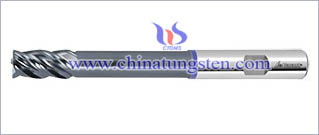Solid Tungsten Carbide End Mill System Ⅴ
- Details
- Category: Tungsten Information
- Published on Monday, 02 November 2015 17:39
In part 4 we know that solid tungsten carbide end mill selection depends most importantly on machining strategy concerning feeds, speeds, depths of cut, which includes two directions: performance driven selection or application driven selections. Here we talk about the basic solid tungsten carbide milling cutter types.
Milling Cutter Type Choices
With approximately five distinct solid tungsten carbide end mill types in existence today for common applications in metallic materials, one generic tool type stands out as being somewhat outdated. It’s a solid tungsten carbide cutter that dates back to the days when small end mills were made of high speed steel (HSS). Historically referred to as the first generation of solid carbide end mills, it has the typical geometrical features that were used in HSS tools at the end of the 1970’s except that its base material has been switched to solid carbide which was found to be suitable for the task at that time. These types of cutters today define the lower end of the market both in terms of cost and performance.
The second group of cutters which in contrast is highly contemporary is the high speed milling type (HSM) of cutters defined for high cutting speeds. These tools typically feature a rather short usable cutting edge length and their design is optimized for maximum stability. With the application of high cutting speeds, high temperatures are generated and this heat typically accumulates in the tool corner. This is the reason why HSM end mills most often have larger corner radii for extra protection against plastic deformation in this area.
The third group for high performance milling (HPM) that holds tools specifically designed for high depths of cut and larger arc of engagement. The depth of cut being the optimizing factor here, the tool design reflects this with long cutting edge length and chip dividers to make large chip volumes more manageable. Helix angles and chip cavity capacity are other visible elements of importance. Increased cutter core diameters are also found with these tools. Their aim is to increase tool stability and again reduce deflection.
(To be continued. This article is divided into several parts and this is part 5, for part 4 please refer to http://news.chinatungsten.com/en/tungsten-information/79882-ti-10226; for part 6 please refer to http://news.chinatungsten.com/en/tungsten-information/79931-ti-10236)

Tungsten Carbide Manufacturer & Supplier: Chinatungsten Online - http://www.tungsten-carbide.com.cn
Tel.: 86 592 5129696; Fax: 86 592 5129797
Email:sales@chinatungsten.com
Tungsten & Molybdenum Information Bank: http://i.chinatungsten.com
Tungsten News & Tungsten Prices, 3G Version: http://3g.chinatungsten.com
Molybdenum News & Molybdenum Price: http://news.molybdenum.com.cn



 sales@chinatungsten.com
sales@chinatungsten.com